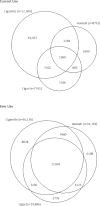Waterpipe smoking among U.S. university students
- PMID: 22641433
- PMCID: PMC3524056
- DOI: 10.1093/ntr/nts076
Waterpipe smoking among U.S. university students
Abstract
Introduction: While cigarette use is declining, smoking tobacco with a waterpipe is an emerging trend. We aimed to determine the prevalence of waterpipe use in a large diverse sample of U.S. university students and to assess the association of waterpipe use with individual and institution-related characteristics.
Methods: We assessed students from 152 U.S. universities participating in the National College Health Assessment during 2008-2009. We used multivariable regression models to determine independent associations between individual and institutional characteristics and waterpipe tobacco use in the past 30 days and ever.
Results: Of 105,012 respondents included in the analysis, most were female (65.7%), White (71.2%), and attending public (59.7%) nonreligious (83.1%) institutions. Mean age was 22.1 years. A total of 32,013 (30.5%) reported ever using a waterpipe to smoke tobacco. Rates for current tobacco use were 8.4% for waterpipes, 16.8% for cigarettes, 7.4% for cigars (including cigarillos), and 3.5% for smokeless tobacco. Of current waterpipe users, 51.4% were not current cigarette smokers. Although current waterpipe use was reported across all individual and institutional characteristics, fully adjusted multivariable models showed that it was most strongly associated with younger age, male gender, White race, fraternity/sorority membership, and nonreligious institutions in large cities in the western United States.
Conclusions: After cigarettes, waterpipe use was the most common form of tobacco use among university students. Because waterpipe use affects groups with a wide variety of individual and institutional characteristics, it should be included with other forms of tobacco in efforts related to tobacco surveillance and intervention.
Figures


References
-
- Akl EA, Gaddam S, Gunukula SK, Honeine R, Jaoude PA, Irani J. The effects of waterpipe tobacco smoking on health outcomes: A systematic review. International Journal of Epidemiology. 2010;39:834–857. - PubMed
-
- American College Health Association. Sample survey: ACHA-NCHA II. 2011. Retrieved from http://www.acha-ncha.org/sample_survey.html.
-
- Bombard JM, Rock VJ, Pederson LL, Asman KJ. Monitoring polytobacco use among adolescents: Do cigarette smokers use other forms of tobacco? Nicotine & Tobacco Research. 2008;10:1581–1589. - PubMed
-
- Centers for Disease Control and Prevention. Youth risk behavior surveillance—United States, 2009. Morbidity & Mortality Weekly Report. 2010;59:1–142. - PubMed
Publication types
MeSH terms
Grants and funding
LinkOut - more resources
Full Text Sources
Miscellaneous

